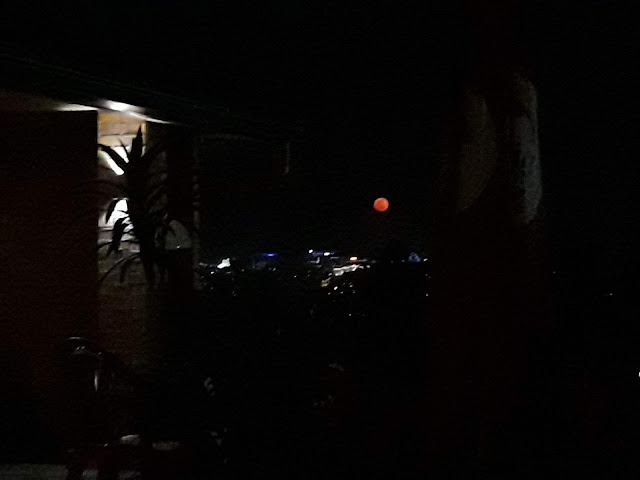Little bit of sad news to start off with. Hobnob didn't make it. She did well for another week but then went into a sudden decline. She died safe and warm at our local veterinary surgery last week. All really sad about it, but her final days were spent comfortably. We were privileged to have known her.
In wildlife-related news. Found a huge fruit chafer beetle. Relocated it outdoors, where it took a shine to my pants drying on the hedge.
Went for drinks with my friend Chris and witnessed the most incredible blood moon. I thought it was a firework when I first saw it. The picture doesn't really show, but it was huge. Really deep red that rose to become white.
And went for a lovely home-cooked meal of potatoes, salad and isombe (cassava leaves), made by my friend Pieter. A nice afternoon spent relaxing and catching up.
My friend from up north came down to visit for the weekend and spoilt me rotten. We've been on a food and cocktail binge. Discovered giant prawns at Zen, and daiquiris that tasted like lemon drops. They were delicious, and right up there with the Hut's passion fruit mojitos.
We had the laziest Saturday on record. Lounged until around 1 p.m., then took a leisurely drive out to 1000 Hills Distillery, which is a place I'd wanted to visit for a while. It was a nice hangout, with a beautiful view of the valley, and friendly staff. They have about five pages of cocktails and one page of food, so we set about sampling the wares.
It was interesting. They've certainly got the alcohol part down, but infusion still has a way to go. They make coffee liqueur, macadamia nut liqueur, rum and whiskey, but they all taste pretty similar, except for the coffee, which is almost strong enough to dampen down the pure alcohol taste. The slight difficulty is that they make all of their cocktails with their own spirits. They look fabulous, but taste-wise, nowhere near a Zen daiquiri. Still, it was a very pleasant afternoon, and we finished up with food and a trip back into our youth with a couple of shandies.
Being a cat momma can be hard. Sometimes you just have to put your pride aside and smuggle a small box of chicken bones home.
In the evening, we went out for a drink with friends Chris and Solvejg, then spent another lazy morning with breakfast at Terra Café, which is a lovely little place next to my house. Didn't have far to walk. Then home for a nap on the couch before he headed back up to Gisenyi. Laziest weekend in a long time.
Things up there are interesting at the moment. Ebola recently spread from DRC to Uganda, killing a child and his grandmother. That was swiftly contained. Then worst fears were realised when a case was reported in Goma, a major transport hub near the border with Rwanda. There's only about five miles between Goma and Gisenyi. The rumour is the guy was a pastor, who thought it was a good idea to go lay hands on people in an infected Ebola region, then evaded checkpoint tests by taking paracetamol to suppress his fever. Others say he used different names at checkpoints to avoid tracking. Not sure how much of that is true, but it's a minor miracle no one else he came into contact with caught it, as he was travelling by public transport. Unfortunately, he has since died.
I'm likely to go up to Gisenyi again in the next few weeks, but think I'll hire a car and get some driving practise in, or catch a lift with friends. We've decided, although the risk is extremely low, it's probably best to avoid public transport for the time being. Many of the buses going south carry people who have crossed from Goma, and until the situation is completely under control, it's probably prudent to find alternative means.
Anyway, I'm going to go and do some more sleeping, and possibly Netflix, with the last of my Sunday. Yay for lazy weekends.

























































































